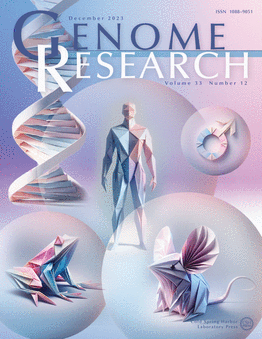人RNA解旋酶DDX3X和DDX3Y的转录后交叉和自动调节缓冲表达
IF 6.2
2区 生物学
Q1 BIOCHEMISTRY & MOLECULAR BIOLOGY
引用次数: 0
摘要
y连锁基因DDX3Y及其x连锁同源基因DDX3X在人类性染色体从普通常染色体进化而来的过程中幸存下来。DDX3X编码一种多功能RNA解旋酶,其突变可导致发育障碍和癌症。我们发现,在具有存活的Y同源物的x连锁基因中,DDX3X对剂量非常敏感。研究性染色体非整倍体个体的细胞,我们观察到当Y染色体数量增加时,DDX3X转录物水平下降;相反,当X染色体数量增加时,DDX3Y转录物水平下降。在46xy细胞中,CRISPRi敲低DDX3X或DDX3Y都会导致同源基因的转录水平升高。在46xx细胞中,DDX3X蛋白活性的化学抑制引起DDX3X转录物水平的增加。因此,DDX3X或DDX3Y表达的扰动被缓冲:在46,XY细胞中,DDX3X和DDX3Y负向交叉调节,在46,XX细胞中,DDX3X负向自我调节。DDX3X - DDX3Y交叉调节是通过mRNA不稳定介导的(如新转录rna的代谢标记所示),并缓冲人细胞中DDX3X和DDX3Y蛋白的总水平。我们推断,祖先(常染色体)DDX3X基因的转录后自调控转变为DDX3X和DDX3Y的自调控和交叉调控,因为这些性别连锁基因是从常染色体前体的普通等位基因进化而来的。本文章由计算机程序翻译,如有差异,请以英文原文为准。
Post-transcriptional cross- and auto-regulation buffer expression of the human RNA helicases DDX3X and DDX3Y
The Y-linked gene DDX3Y and its X-linked homolog DDX3X survived the evolution of the human sex chromosomes from ordinary autosomes. DDX3X encodes a multifunctional RNA helicase, with mutations causing developmental disorders and cancers. We find that, among X-linked genes with surviving Y homologs, DDX3X is extraordinarily dosage sensitive. Studying cells of individuals with sex chromosome aneuploidy, we observe that when the number of Y Chromosomes increases, DDX3X transcript levels fall; conversely, when the number of X Chromosomes increases, DDX3Y transcript levels fall. In 46,XY cells, CRISPRi knockdown of either DDX3X or DDX3Y causes transcript levels of the homologous gene to rise. In 46,XX cells, chemical inhibition of DDX3X protein activity elicits an increase in DDX3X transcript levels. Thus, perturbation of either DDX3X or DDX3Y expression is buffered: by negative cross-regulation of DDX3X and DDX3Y in 46,XY cells and by negative auto-regulation of DDX3X in 46,XX cells. DDX3X–DDX3Y cross-regulation is mediated through mRNA destabilization—as shown by metabolic labeling of newly transcribed RNA—and buffers total levels of DDX3X and DDX3Y protein in human cells. We infer that post-transcriptional auto-regulation of the ancestral (autosomal) DDX3X gene transmuted into auto- and cross-regulation of DDX3X and DDX3Y as these sex-linked genes evolved from ordinary alleles of their autosomal precursor.
求助全文
通过发布文献求助,成功后即可免费获取论文全文。
去求助
来源期刊

Genome research
生物-生化与分子生物学
CiteScore
12.40
自引率
1.40%
发文量
140
审稿时长
6 months
期刊介绍:
Launched in 1995, Genome Research is an international, continuously published, peer-reviewed journal that focuses on research that provides novel insights into the genome biology of all organisms, including advances in genomic medicine.
Among the topics considered by the journal are genome structure and function, comparative genomics, molecular evolution, genome-scale quantitative and population genetics, proteomics, epigenomics, and systems biology. The journal also features exciting gene discoveries and reports of cutting-edge computational biology and high-throughput methodologies.
New data in these areas are published as research papers, or methods and resource reports that provide novel information on technologies or tools that will be of interest to a broad readership. Complete data sets are presented electronically on the journal''s web site where appropriate. The journal also provides Reviews, Perspectives, and Insight/Outlook articles, which present commentary on the latest advances published both here and elsewhere, placing such progress in its broader biological context.
 求助内容:
求助内容: 应助结果提醒方式:
应助结果提醒方式:


